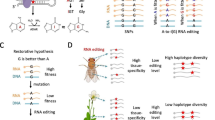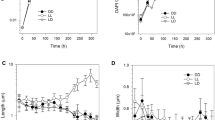Abstract
Alternative splicing (AS) is thought to enhance transcriptome diversity dramatically and play an important role in stress adaptation. While well studied in vertebrates, AS remains poorly understood in invertebrates. Here, we used high-throughput RNA-sequencing data to perform a genome-wide survey of AS in the Pacific oyster (Crassostrea gigas), an economically important mollusk that is cultivated worldwide. This analysis identified 8223 AS events corresponding to 4480 genes in the Pacific oyster, suggesting that about 16 % of oyster multiexonic genes undergo AS. We observed that a majority of the identified AS events were related to skipped exons (37.8 %). Then Gene Ontology analysis was conducted to analyze the function of the genes that undergo AS and the genes that produce more than five AS isoforms. After that, the expression of AS isoforms facing temperature, salinity, and air exposure challenge were examined. To validate our bioinformatic-predicted results and examine whether AS affects stress adaptation, we selected heat-shock protein 60 (HSP60) and HSP90 genes, both of which experience AS, for reverse transcription PCR (RT-PCR). We also performed quantitative real-time PCR (qRT-PCR) to determine the relative expression of each AS isoform among different stress adapted populations. Our study indicates that AS events are likely complex in the Pacific oyster and may be related to stress adaptation. These results will complement the predicted gene database of C. gigas and provide an invaluable resource for future functional genomic studies on molluscs.








Similar content being viewed by others
References
Ast G (2004) How did alternative splicing evolve? Nat Rev Genet 5:773–782
Berget SM (1995) Exon recognition in vertebrate splicing. J Biol Chem 270:2411–2414
Campbell MA, Haas BJ, Hamilton JP, Mount SM, Buell CR (2006) Comprehensive analysis of alternative splicing in rice and comparative analyses with Arabidopsis. BMC Genomics 7:327
Chang Y-F, Imam JS, Wilkinson MF (2007) The nonsense-mediated decay RNA surveillance pathway. Annu Rev Biochem 76:51–74
Chen S, Yang P, Jiang F, Wei Y, Ma Z, Kang L (2011) De novo analysis of transcriptome dynamics in the migratory locust during the development of phase traits. PLoS One 5:e15633
Chen L, Tovar-Corona JM, Urrutia AO (2012) Alternative splicing: a potential source of functional innovation in the eukaryotic genome. Int J Evol Biol 2012:596274
Daines B et al (2011) The Drosophila melanogaster transcriptome by paired-end RNA sequencing. Genome Res 21:315–324
Ding F, Cui P, Wang Z, Zhang S, Ali S, Xiong L (2014) Genome-wide analysis of alternative splicing of pre-mRNA under salt stress in Arabidopsis. BMC Genomics 15:431
Feder ME, Hofmann GE (1999) Heat-shock proteins, molecular chaperones, and the stress response: evolutionary and ecological physiology. Annu Rev Physiol 61:243–282
Galante PAF, Sakabe NJ, Kirschbaum-Slager N, De Souza SJ (2004) Detection and evaluation of intron retention events in the human transcriptome. RNA 10:757–765
Gamazon ER, Stranger BE (2014) Genomics of alternative splicing: evolution, development and pathophysiology. Hum Genet 133:679–687
Graveley BR et al (2011) The developmental transcriptome of Drosophila melanogaster. Nature 471:473–479
Jiang H, Kim HG, Park Y (2015) Alternatively spliced orcokinin isoforms and their functions in Tribolium castaneum. Insect Biochem Mol Biol 65:1–9
Jouaux A, Franco A, Heude-Berthelin C, Sourdaine P, Blin JL, Mathieu M, Kellner K (2012) Identification of Ras, Pten and p70S6K homologs in the Pacific oyster Crassostrea gigas and diet control of insulin pathway. Gen Comp Endocrinol 176:28–38
Kelemen O, Convertini P, Zhang Z, Wen Y, Shen M, Falaleeva M, Stamm S (2012) Function of alternative splicing. Gene 514:1–30
Lu J et al (2010) Alternative splicing in teleost fish genomes: same-species and cross-species analysis and comparisons. Mol Gen Genomics 283:531–539
Maniatis T (1991) Mechanisms of alternative pre-mRNA splicing. Science 251:33–34
Maquat LE (2004) Nonsense-mediated mRNA decay: splicing, translation and mRNP dynamics. Nat Rev Mol Cell Biol 5:89–99
Marquez Y, Brown JW, Simpson C, Barta A, Kalyna M (2012) Transcriptome survey reveals increased complexity of the alternative splicing landscape in Arabidopsis. Genome Res 22:1184–1195
Mastrangelo AM, Marone D, Laido G, De Leonardis AM, De Vita P (2012) Alternative splicing: enhancing ability to cope with stress via transcriptome plasticity. Plant Sci 185-186:40–49
Meng J et al (2013) Genome and transcriptome analyses provide insight into the euryhaline adaptation mechanism of Crassostrea gigas. PLoS One 8:e58563
Modrek B, Lee C (2002) A genomic view of alternative splicing. Nat Genet 30:13–19
Okada Y, Yamaura K, Suzuki T, Itoh N, Osada M, Takahashi KG (2013) Molecular characterization and expression analysis of chitinase from the Pacific oyster Crassostrea gigas. Comp Biochem Physiol B Biochem Mol Biol 165:83–89
Pan Q, Shai O, Lee LJ, Frey BJ, Blencowe BJ (2008) Deep surveying of alternative splicing complexity in the human transcriptome by high-throughput sequencing. Nat Genet 40:1413–1415
Piao X, Hou N, Cai P, Liu S, Wu C, Chen Q (2014) Genome-wide transcriptome analysis shows extensive alternative RNA splicing in the zoonotic parasite Schistosoma japonicum. BMC Genomics 15:715
Ramani AK et al (2011) Genome-wide analysis of alternative splicing in Caenorhabditis elegans. Genome Res 21:342–348
Reddy AS (2007) Alternative splicing of pre-messenger RNAs in plants in the genomic era. Annu Rev Plant Biol 58:267–294
Reddy AS, Marquez Y, Kalyna M, Barta A (2013) Complexity of the alternative splicing landscape in plants. Plant Cell 25:3657–3683
Roberts GC, Smith CWJ (2002) Alternative splicing: combinatorial output from the genome. Curr Opin Chem Biol 6:375–383
Rodrigues R, Grosso AR, Moita L (2013) Genome-wide analysis of alternative splicing during dendritic cell response to a bacterial challenge. PLoS One 8:e61975
Schmittgen TD, Livak KJ (2008) Analyzing real-time PCR data by the comparative C-T method. Nat Protoc 3:1101–1108
Shao W et al (2012) Alternative splicing and trans-splicing events revealed by analysis of the Bombyx mori transcriptome. RNA 18:1395–1407
She Z, Li L, Qi H, Song K, Que H, Zhang G (2015) Candidate gene polymorphisms and their association with glycogen content in the Pacific oyster Crassostrea gigas. PLoS One 10:e0124401
Shen Y et al (2014) Global dissection of alternative splicing in paleopolyploid soybean. Plant Cell 26:996–1008
Sorensen JG, Kristensen TN, Loeschcke V (2003) The evolutionary and ecological role of heat shock proteins. Ecol Lett 6:1025–1037
Srivastava P (2002) Roles of heat-shock proteins in innate and adaptive immunity. Nat Rev Immunol 2:185–194
Sultan M et al (2008) A global view of gene activity and alternative splicing by deep sequencing of the human transcriptome. Science 321:956–960
Syed NH, Kalyna M, Marquez Y, Barta A, Brown JW (2012) Alternative splicing in plants—coming of age. Trends Plant Sci 17:616–623
Thanaraj TA, Stamm S (2003) Prediction and statistical analysis of alternatively spliced exons. Prog Mol Subcell Biol 31:1–31
Trapnell C, Pachter L, Salzberg SL (2009) TopHat: discovering splice junctions with RNA-seq. Bioinformatics 25:1105–1111
Tsan MF, Gao BC (2004) Heat shock protein and innate immunity. Cell Mol Immunol 1:274–279
Venables JP, Tazi J, Juge F (2012) Regulated functional alternative splicing in Drosophila. Nucleic Acids Res 40:1–10
Walters B, Lum G, Sablok G, Min XJ (2013) Genome-wide landscape of alternative splicing events in Brachypodium distachyon. DNA Res 20:163–171
Wan QY, Su JG (2015) Transcriptome analysis provides insights into the regulatory function of alternative splicing in antiviral immunity in grass carp (Ctenopharyngodon idella. Sci Report 5:12946
Wang BB, Brendel V (2006) Genomewide comparative analysis of alternative splicing in plants. Proc Natl Acad Sci U S A 103:7175–7180
Wang ET et al (2008) Alternative isoform regulation in human tissue transcriptomes. Nature 456:470–476
Wang G, Zhong M, Wang J, Zhang J, Tang Y, Wang G, Song R (2014a) Genome-wide identification, splicing, and expression analysis of the myosin gene family in maize (Zea mays). J Exp Bot 65:923–938
Wang WJ et al (2014b) Detection of alternative splice and gene duplication by RNA sequencing in Japanese flounder, Paralichthys olivaceus. G3 (Bethesda) 4:2419–2424.
Young MD, Wakefield MJ, Smyth GK, Oshlack A (2010) Gene ontology analysis for RNA-seq: accounting for selection bias. Genome Biol 11:R14
Zhang G et al (2010) Deep RNA sequencing at single base-pair resolution reveals high complexity of the rice transcriptome. Genome Res 20:646–654
Zhang G et al (2012) The oyster genome reveals stress adaptation and complexity of shell formation. Nature 490:49–54
Zhang G, Li L, Meng J, Qi H, Qu T, Xu F, Zhang L (2015a) Molecular basis for adaptation of oysters to stressful marine intertidal environments. Annu Rev Anim Biosci
Zhang L, Li L, Guo X, Litman GW, Dishaw LJ, Zhang G (2015b) Massive expansion and functional divergence of innate immune genes in a protostome. Sci Report 5:8693
Zheng CL, Fu XD, Gribskov M (2005) Characteristics and regulatory elements defining constitutive splicing and different modes of alternative splicing in human and mouse. RNA 11:1777–1787
Acknowledgments
This research was supported by Shandong Provincial Natural Science Foundation (ZR2013DQ010), National Natural Science Foundation of China (31530079), National Basic Research Program of China (973 Program, No.2010CB126402), the Earmarked Fund for Modern Agro-industry Technology Research System (CARS-48), and Taishan Scholars Climbing Program of Shandong.
Author information
Authors and Affiliations
Corresponding author
Ethics declarations
Conflict of Interest
The authors declare that they have no conflict of interest.
Additional information
Baoyu Huang and Linlin Zhang contributed equally to this work.
Electronic supplementary material
Supplementary file 1
(DOCX 361 kb)
Supplementary file 2
(DOCX 1054 kb)
Supplementary file 3
(DOCX 8 kb)
Supplementary file 4
(DOCX 223 kb)
Supplementary file 5
(DOCX 12 kb)
Supplementary file 6
(DOCX 10 kb)
Supplementary file 7
(DOCX 13 kb)
Rights and permissions
About this article
Cite this article
Huang, B., Zhang, L., Tang, X. et al. Genome-Wide Analysis of Alternative Splicing Provides Insights into Stress Adaptation of the Pacific Oyster. Mar Biotechnol 18, 598–609 (2016). https://doi.org/10.1007/s10126-016-9720-x
Received:
Accepted:
Published:
Issue Date:
DOI: https://doi.org/10.1007/s10126-016-9720-x




